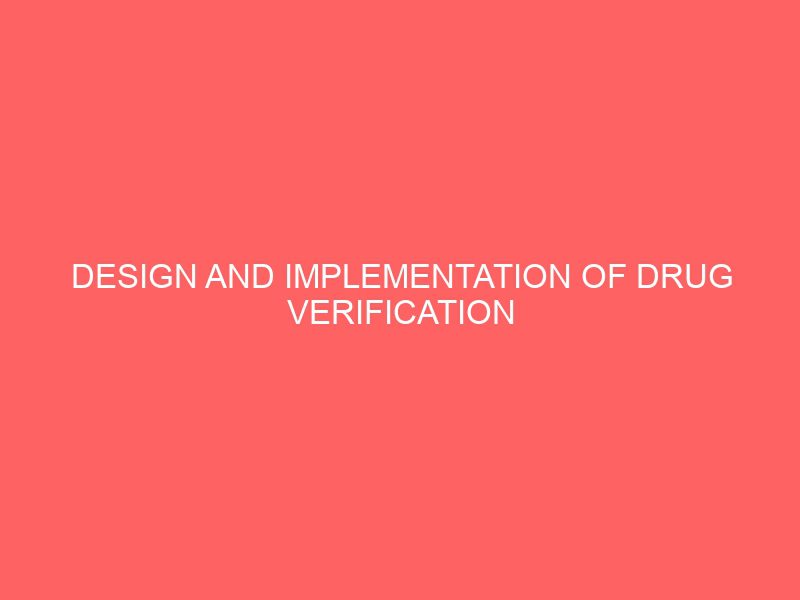![]()
E-PAYMENT RISKS AND CONTROL TECHNIQUE IN GOVERNMENT.
ABSTRACT
The study examines electronic payment risks and control techniques in government with specific focus on Enugu State University of Science and Technology (ESUT). Some of the specific objectives are: To examine the need for legislation or a notional policy on Information Technology (IT) development. More so, simply table and percentage distribution was used in analyzing data, while the primary and secondary sources of data were both used in gathering of data. The study made some findings which includes the electronic payment has its positive and negative impacts. The positive impacts as noted were speed, convinces, quality service in fund transfers between and among ministries, Department and Agencies in government. However, some recommendations were made which includes; the need for government to make policy/legislation or information technology and development, government employees needs to be trained and retrained on the usage/application of electronic payment systems and administration, government establishments should create hard copies of their electronic transactions as a back up and reference unit purpose.
CHAPTER ONE
1.1 Background of the Study
Payment methods have evolved from the physical exchange of notes and coins through the transferring of payment card details either in person, over the phone or the Internet. This evolution has involved a shift from physical transference of tangible tokens of value to an exchange of information between parties (Okunbor, Ateli and Asogwa, 2010). The introduction of e-payment has further digitalized the payment process, whereby payment details are sent over open networks with no physical contact between the buyer and the seller. Electronic payment is a subject of e-commerce transaction which includes electronic payments for buying and selling of goods or services offered through the Internet (Okunbor, Ateli and Asogwa, 2010).
Generally, we think of electronic payment as referred to on-line transactions on the Internet, there are many forms of electronic payments. It can be viewed as electronic means in the interaction between government and citizens and government and business (Okunbor, Ateli and Asogwa, 2010). It is the form of direct payments and banking without physical appearance at the Ministry, Departments and Agencies for bank through the means of electronic interactive communication channels and other technology infrastructure. All over the world financial systems and mode of transaction are changing rapidly. The inclination in developed countries is to move towards electronic payment than any other form of payment for convenient, fast and easy business transactions. For Nigeria to join this league of developed economies by 2020, e-payment needs to form the bedrock for all financial transactions. For an effective e-government, e-payment is a component for businesses to thrive and most businesses are going electronic in their transaction.
Okunbor, Ateli and Asogwa (2010) citing Okunbor (2000) had noted electronic business transactions as the use of advanced information and communication technology (ICT) tools to create new business relationships and enhance existing ones and increase generic approach to enhancing end to end e-Payment in governance, the efficiency of business flow processes without the constraints of time or geographical barriers. For businesses and entrepreneurs in Nigeria to take advantage of the benefits of e-payment scheme there must be need for trust, secure, secure transaction and network payment services. Given the high level of fraud and corrupt practices perpetuated in government establishments the ideas of electronic payment is one whose time has long been due.
With the advent of information technology taking over most operations like record keeping, data processing, financial transaction both in public and private sectors. The concept of cash payments and paper money transactions are increasingly becoming outdated even in the Third World (Okunbor, Ateli and Asogwa, 2010). The Federal government decision that, all payments and financial transactions in government be done electronically is therefore a good one. The old order was characterized by leakages, delays, kick-backs, blackmail and all kinds of negative tendencies. The e-payment scheme is expected to promote efficiency, eliminate bottlenecks, human errors and more importantly reduce c9orruption. Dankwanbo (2009) as cited by Okunbor, Ateli and Asogwa, (2010), posited that the world economic meltdown employed the excess crude oil reserve to finance the 2009 budget deficit because of paucity of funds. The major revenue earner of the government suffered decrease in valuation internationally. The fracas in 2009 in the Niger Delta region militated against meeting Nigeria quota in the supply of crude to the international market. These problems which the government faced in administering the state led to no fund and inability for government to deliver. According to him, it was in pursuance of these problems that the President of the Federal Republic of Nigeria during the presentations of the 2009 budget to the National Assembly introduced a number of measures for ensuring transparency and accountability. “This it is expected will lend credence to his ambition of delivering tolerable and good governance”. One of the measures was the unveiling of e-payment regime directing that all financial transactions of the Federal Government be made electronically.
An electronic payment method is a subset of e-governance (Okunbor Ateli and Asogwa, 2010). E-government has been defined as away for government to use new technologies to provide people with more convenient access to government information and services, to improve the quality of the services and provide greater opportunities to participate in democratic institutions and processes. E-governance presents Nigeria with huge opportunities to move firmly into the 21st century with higher quality cost effective government services and better relationship between Nigerians and their government. An electronic payment system as a component of e-government is the application of electronic means in the interaction between government and citizens, government and business. It is a form of direct payment and banking without physical appearance at the Ministry/Departments/Agency MDA or Bank through the means of electronic interactive communication channels and other technology infrastructure. It can also be described as the method of effecting payment from one end to another end through the medium of the computer without manual intervention beyond inputting the payment data. The benefits are enormous:
· It will eliminate cheques writing, thereby eliminating the risk associated with cheques been stolen, forging of signatures, disparity between amount in words and figures.
· Transparency and Accountability in government operations will be improved; this will lead to economic growth and development.
· It will assist corruption fighting agencies like the Economic and Financial Crime Commission EFCC and ICPC (Independent Corrupt Practices Commission) in cases of investigation as this will reduce cases of corruption.
· It leads to the beginning of a cashless society; there will be easy tracking of payments to beneficiaries account hence it will assist audit trails. Overall increase in the efficiency of operation will reduce transaction cost; enable transactions of very low value.
· There will be increased convenience of payment that can be made swiftly and remotely using various devices.
· Accountants will appreciate information technology more and this will improve the quality of financial reports generated by MDA’s and reporting will be real time.
1.2 Statement of the Problem.
Ayo and Babajide (2006) attributed the slow space of development of e-payment to lack of adequate infrastructure, low Internet penetration, absence of open standards/trust among government institutions and agencies and providers as well as absence of adequate legislation or national policy on IT development. According to Olesin (2006) and Ezeoha (2006) as cited by Ayo and Babajide (2006), image problem was another issue. The Advance Feed Fraud code-named 419, is one of the most popular Internet frauds and it probably had its origin from Nigeria. Lately, the country has been very prominent among the list of fraudulent nations. Consequently, there has been outright rejection of payment card issued by Nigerian institutions on the international arena.
Generally, Ayo and Babajide (2006), citing Denny (1998) attributed e-payment problems to the issues of customer identification and account verification of online purchaser. Another issue is lack of security. There is need to put in place effective security measures to safeguard the client, server as well as the media of transmission (Ghosh, 1997) as cited by (Ayo and Babajide, 2006).
1.3 Objectives of the Study
To assess e-payment risks and control techniques in government other objectives of this research work includes:
· To ascertain the relationship between inadequate infrastructures and development of e-payment in government;
· To examine the need for legislation or a national policy on information technology (IT) development;
· To asses the need for a secure, reliable, efficient, auditable and traceable e-payment system.
1.4 Research Questions
· What is the relationship between inadequate infrastructures and the development of e-payment?
· Is there a need for legislation or a national policy on information technology (IT) development?
· Is there a need for a secure, reliable, efficient, auditable and traceable e-payment system?
1.5 Formulation of Hypotheses
1. Ho: There is no relationship between inadequate infrastructures and the development of e-payment in government.
Hi: There is a relationship between inadequate infrastructures and the development of e-payment in government.
2. Ho: There is no need for legislation or a national policy on information Technology (IT) development.
Hi: There is a need for legislation or a national policy on information Technology (IT) development.
3. Ho: There is no need for a secure, reliable, efficient, auditable and traceable e-payment system.
4. Hi: There are frameworks for a secure, reliable, efficient, auditable and traceable e-payment system.
1.6 Significance of the Study
Against the backdrop of the mediocrity observed, in the public sector performance, where chequeing system has been abused. With the new practice payments to government workers, contractors and other government agencies will be done electronically. This way the rampant case of ghost workers through which government is heavily defrauded is supposed to be eliminated. In the same way, tax payments, remittances by service provides government agencies, parastatals are also supposed to be done electronically, and this is expected to plug leakages in government finances. Another significance of the e-payment system is to check the huge transfer of cash within Federal Ministries, departments and agencies across the country and also will help for proper planning, directing, organization and control of government operations. It will also be a very effective means through which the citizenry and the government communicate effectively as well as a means for government to appraise her performance by way of feedback from her citizenry.
1.7 Scope of the Study
The scope of this study is limited to e-payment risk and control techniques in government with specific focus on Enugu State University of Science and Technology (ESUT). Within the limited range of the next few pages, this report attempts to present a snapshot of the conceptual overview of electronic payment, state of e-payment in Nigeria, current government e-pay option and implications, types of electronic payment systems, usages of e-payment systems, critical challenges and electronic payment system processes in government.
1.8 Limitations of the Study
There has not been any serious and meaningful academic endeavor without some militating factors or constraints. To that extent, lack of financial resources, and time constraint constituted the most serious limitations of this work. Again, the relative disclosure of information by the staff and management (respondents) of the organization understudy was also a constraint.
1.9 Definition of Terms
E-payment: This is electronic means in the interaction between government and citizens and government and businesses.
E-government: This is a way for government to use new technologies to provide people with more convenient access to government information and services, to improve the quality of the services and provide greater opportunities to participate in democratic institutions and processes.
E-commerce: These are transactions which include electronic payments for buying and selling of goods or services offered through the Internet.
Risk: A situation involving exposure to danger.
Control: It is a mechanism installed or instituted to guide or regulate the activities or operation of an apparatus, machine, person, or system.























